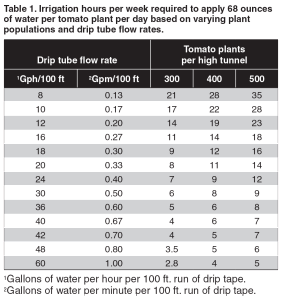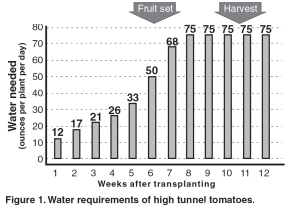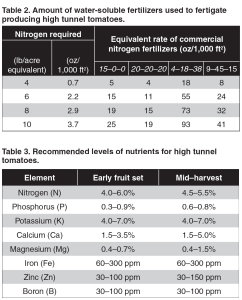Lewis W. Jett, Division of Plant Sciences
Successful production of tomatoes within a high tunnel hinges on proper watering and fertilization. High tunnels exclude natural rainfall, so timely irrigation is important. Because tomato fruits are more than 90 percent water, yield and quality suffer when plants are under drought stress. When tomatoes are not adequately watered, there are fewer flowers per truss, less fruit will develop and blossom end rot will occur.
 Drip irrigation is the most efficient method of delivering water and nutrients to high tunnel tomatoes. Using a small, collapsible tube (3⁄4 inch diameter),water is slowly applied to the plant without wetting the foliage. Drip tape is usually 8-10 mil thickness and is buried 1–2 inches deep. Dripper or emitter spacing is typically 4-12 inches. Tomatoes require a single drip line per row; offset about 2 inches from the plant. Flow rates of drip tapes vary; most growers choose a medium-flow tape (1⁄2 gallon per minute (gpm) per 100 feet). High–flow tape (0.8-1.0 gpm) is useful to prevent clogging and reduce irrigation time (Table 1).
Drip irrigation is the most efficient method of delivering water and nutrients to high tunnel tomatoes. Using a small, collapsible tube (3⁄4 inch diameter),water is slowly applied to the plant without wetting the foliage. Drip tape is usually 8-10 mil thickness and is buried 1–2 inches deep. Dripper or emitter spacing is typically 4-12 inches. Tomatoes require a single drip line per row; offset about 2 inches from the plant. Flow rates of drip tapes vary; most growers choose a medium-flow tape (1⁄2 gallon per minute (gpm) per 100 feet). High–flow tape (0.8-1.0 gpm) is useful to prevent clogging and reduce irrigation time (Table 1).
Another distinct advantage of drip irrigation is the ability to inject water-soluble nutrients through the irrigation system, a technique that is called fertigation. Rather than applying all the nutrients at once (either at planting or before), the nutrients and water can be applied as the crop grows (Figure 1). Fertigation saves both water and fertilizer.
The critical growth periods for adequate watering of tomatoes are during flowering, fruit set and fruit development. Flowers are observed on tomatoes beginning about four weeks after transplanting. Determinate varieties have a concentrated period of flowering, whereas indeterminate tomatoes flower continuously through the growing season. Tomatoes begin developing fruit about six weeks after transplanting, and adequate watering is important for the fruit to develop and attain proper size. As the fruit continues to grow, 2-2.5 quarts of water per plant will be needed (Figure 1).
Many water-soluble fertilizers can be used in the fertilization program for tomatoes. Generally speaking, large quantities of phosphorus and potassium should not be applied through the drip irrigation system. Rather, a soil test should be taken before the crop is planted (preferably the fall) and all of the phosphorus and most of the potassium can be applied before planting or between cropping cycles within the high tunnel. Potassium should be fertigated during fruit ripening to improve color and taste of tomatoes.
 Nitrogen is used by tomatoes for vine growth. Tomato plants that are low in nitrogen appear stunted and spindly with a yellowish cast to the leaves. Too much nitrogen creates excessive vine growth, twisted foliage, delayed flowering and lower marketable yield. About 40–50 percent of the total seasonal nitrogen can be applied at planting, and the balance can be applied through the drip system over the course of the growing season. Many organic sources of nitrogen such as compost, alfalfa meal and soybean meal can be applied and mixed with the soil before planting tomatoes.
Nitrogen is used by tomatoes for vine growth. Tomato plants that are low in nitrogen appear stunted and spindly with a yellowish cast to the leaves. Too much nitrogen creates excessive vine growth, twisted foliage, delayed flowering and lower marketable yield. About 40–50 percent of the total seasonal nitrogen can be applied at planting, and the balance can be applied through the drip system over the course of the growing season. Many organic sources of nitrogen such as compost, alfalfa meal and soybean meal can be applied and mixed with the soil before planting tomatoes.
For each 1 percent of organic matter in the soil, there can be as much as 20 pounds of residual nitrogen per acre. Thus, if soil organic matter is greater than 3 percent, no preplant nitrogen is necessary. However, if the soil organic matter is less than 3 percent and no organic residues have been added to the soil, 1-1.5 pounds of actual nitrogen per 1,000 square feet can be applied before transplanting tomatoes in the high tunnel.
Fertigation of nitrogen can be applied based on the volume of wate r applied by irrigation or based on area. Most tomato roots will be concentrated in a 24- to 30-inch-wide section of the bed or row. Multiplying this root zone width by the length of each row and the total numb er of rows of tomatoes equals the effective bed width. Additional nitrogen can be applied through the drip irrigation system at a rate of 8–10 lb/acre/week (2.9–3.7 ounces/1,000 ft 2/week) (Table 2). Foliar feeding of nitrogen, phosphorus and potassium is not effective relative to soil application of these major nutrients. Fertilizer nitrogen is available as nitrate or ammonium.Tomatoes respond favorably to nitrate nitrogen. Nitrate nitrogen is readily available to the plant and typically has low salt relative to ammonium fertilizers (ammonium nitrate, urea). Choose nitrogen fertilizers that are low in salt since salt levels can accumulate in the soil in a high tunnel. Many commercial high tunnel tomato growers choose to fertilize with calcium nitrate and then alternate each week with another fertilizer that is high in potassium (4-18-38) particularly during fruit ripening. Calcium improves fruit quality and reduces the incidence of blossom end rot.
r applied by irrigation or based on area. Most tomato roots will be concentrated in a 24- to 30-inch-wide section of the bed or row. Multiplying this root zone width by the length of each row and the total numb er of rows of tomatoes equals the effective bed width. Additional nitrogen can be applied through the drip irrigation system at a rate of 8–10 lb/acre/week (2.9–3.7 ounces/1,000 ft 2/week) (Table 2). Foliar feeding of nitrogen, phosphorus and potassium is not effective relative to soil application of these major nutrients. Fertilizer nitrogen is available as nitrate or ammonium.Tomatoes respond favorably to nitrate nitrogen. Nitrate nitrogen is readily available to the plant and typically has low salt relative to ammonium fertilizers (ammonium nitrate, urea). Choose nitrogen fertilizers that are low in salt since salt levels can accumulate in the soil in a high tunnel. Many commercial high tunnel tomato growers choose to fertilize with calcium nitrate and then alternate each week with another fertilizer that is high in potassium (4-18-38) particularly during fruit ripening. Calcium improves fruit quality and reduces the incidence of blossom end rot.
Tissue testing should be conducted to determine whether the tomato nutrient levels are sufficient. Randomly select 10 to 12 plants per house beginning at flowering or early fruit set. For determinate tomatoes (e.g., ‘Mountain Fresh), break the fifth or sixth limb from the top of the plant and place the entire limb in a brown paper bag. For indeterminate tomatoes (e.g., ‘Trust’), choose a leaf above a fruit that is about 2 inches in diameter. Dry the sample before sending it to a laboratory for analysis. Compare results with recommended levels of each nutrient (Table 3).
Download the paper Watering and Fertilizing Tomatoes in a High Tunnel



